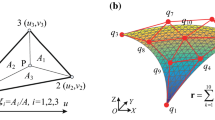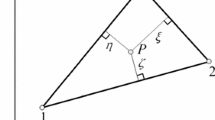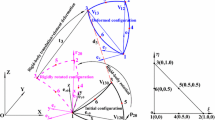Abstract
In this paper, a new unified kinematic description, obtained from Bezier geometry using linear mapping and position vector gradients associated with three independent parameters, is used to develop large displacement plate/shell finite elements (FE). Contrary to the conventional FE method, in the approach developed in this paper based on the absolute nodal coordinate formulation (ANCF), no distinction is made between plate and shell structures. The proposed ANCF triangular plate/shell elements have 12 coordinates per node: three position coordinates and nine position gradient coordinates that define vectors tangent to coordinate lines at the nodes. The fundamental differences between the conventional FE and the new ANCF parameterizations are highlighted. In this investigation, two different parameterizations, each of which employs independent coordinates, are used. In the first parameterization, called volume parameterization, coordinate lines along the sides of the triangular element in the straight (un-deformed) configuration are used in order to facilitate the development of closed-form cubic shape functions. In the second parameterization, called Cartesian parameterization, coordinate lines along the global axes of the structure (body) coordinate system are used to facilitate the element assembly. The element transformation between the volume and the Cartesian parameterizations is developed and used to define the structure inertia and elastic forces. Three new fully parameterized ANCF triangular plate/shell elements are developed in this investigation: a four-node mixed-coordinate element (FNMC) and two three-node elements (TN1 and TN2). All the elements developed in this investigation lead to a constant mass matrix and zero Coriolis and centrifugal forces. A non-incremental total Lagrangian procedure is used for the numerical solution of the nonlinear equations of motion. The performance of the proposed ANCF triangular plate/shell elements is analyzed by comparison with the ANCF rectangular plate element and conventional three-node linear (TNL) and six-node quadratic (SNQ) triangular plate elements.



































Similar content being viewed by others
References
Noor, A.K.: Bibliography of monographs and surveys on shells. Appl. Mech. Rev. 43, 223–234 (1990)
Reddy, J.N.: Theory and Analysis of Elastic Plates and Shells, 2nd edn. CRC Press, Boca Raton (2007)
Armenakas, A.E., Gazis, D.C., Herrmann, G.: Free Vibrations of Circular Cylindrical Shells. Pergamon Press, Oxford (1969)
Ashwell, D.G., Gallagher, R.H. (eds.): Finite Elements for Thin Shells and Curved Members. Wiley, London (1976)
Axelrad, E.L.: Theory of Flexible Shells. North Holland (1987)
Bieger, K.W.: Circular Cylindrical Shells Subjected to Concentrated Radial Loads: Computation Methods and Charts of Influence Surfaces. Springer, Berlin (1976)
Billington, D.P.: Thin Shell Concrete Structures, 2nd edn. McGraw Hill, New York (1982)
Brush, D.O., Almroth, B.O.: Buckling of Bars, Plates and Shells. McGraw-Hill, New York (1975)
Calladine, C.R.: Theory of Shell Structures. Cambridge University Press, Cambridge (1983)
Cox, H.L.: The Buckling of Plates and Shells. Pergamon Press, New York (1963)
Dym, C.L.: Introduction to the Theory of Shells. Pergamon Press, Oxford (1974)
Flugge, W.A.: Stresses in Shells, 2nd edn. Springer, Berlin (1973)
Gould, P.L.: Static Analysis of Shells: A Unified Development of Surface Structures. Lexington Books, Lexington (1977)
Gould, P.L.: Finite Element Analysis of Shells of Revolution. Pitman, Marshfield (1985)
Gould, P.L.: Analysis of Shells and Plates. Springer, New York (1988)
Heyman, J.: Equilibrium of Shell Structures. Clarendon Press, Oxford (1977)
Hinton, E., Owen, D.R.J. (eds.): Finite Element Software for Plates and Shells. Pineridge Press, Swansea, UK (1984)
Huang, H.C.: Static and Dynamic Analysis of Plates and Shells. Springer, New York (1989)
Hughes, T.J.R., Hinton, E. (eds.): Finite Element Methods for Plate and Shell Structures, Vol. 1: Element Technology. Pineridge Press, Swansea (1986)
Hughes, T.J.R., Hinton, E. (eds.): Finite Element Methods for Plate and Shell Structures, Vol. 1: Formulations and Algorithms. Pineridge Press, Swansea (1986)
Kelkar, V.S., Sewell, R.T.: Fundamentals of the Analysis and Design of Shell Structures. Prentice Hall, Englewood Cliffs (1987)
Kratzig, W.B., Onate, E. (eds.): Computational Mechanics of Nonlinear Response of Shells. Springer, NY (1990)
Kraus, H.: Thin Elastic Shells. Wiley, NY (1967)
Kuhn, P.: Stresses in Aircraft Shell Structures. McGraw-Hill, NY (1956)
Timoshenko, S.P., Woinowsky-Krieger, K.: Theory of Plates and Shells, 2nd edn. McGraw-Hill, NY (1959)
Ugural, A.C.: Stresses in Plates and Shells. McGraw-Hill, NY (1981)
Werner, S.: Vibration of Shells and Plates. Marcel Dekker, NY (1981)
Huston, R.L.: Multibody Dynamics. Butterworth-Heineman, Boston (1990)
Nikravesh, P.E.: Computer-Aided Analysis of Mechanical Systems. Prentice Hall, Englewood Cliffs (1988)
Wittenburg, J.: Dynamics of Multibody Systems, 2nd edn. Springer, Berlin (2007)
Guida, D., Nilvetti, F., Pappalardo, C.M.: Dry friction influence on cart pendulum dynamics. Int. J. Mech. 3, 31–38 (2009)
Guida, D., Nilvetti, F., Pappalardo, C.M.: Instability induced by dry friction. Int. J. Mech. 3, 44–51 (2009)
Guida, D., Pappalardo, C.M.: A new control algorithm for active suspension systems featuring hysteresis. FME Trans. 41, 285–290 (2013)
Mikkola, A.M., Shabana, A.A.: A non-incremental finite element procedure for the analysis of large deformation of plates and shells in mechanical system applications. Multibody Syst. Dyn. 9, 283–309 (2003)
Kubler, L., Eberhard, P., Geisler, J.: Flexible multibody systems with large deformations and nonlinear structural damping using absolute nodal coordinates. Nonlinear Dyn. 34, 31–52 (2003)
Guida, D., Pappalardo, C.M.: Forward and inverse dynamics of nonholonomic mechanical systems. Meccanica 49, 1547–1559 (2014)
Kulkarni, S., Pappalardo, C.M., Shabana, A.A.: Pantograph/catenary contact formulations. ASME J. Vib. Acoust. 139, 1–12 (2016)
Pappalardo, C.M.: A natural absolute coordinate formulation for the kinematic and dynamic analysis of rigid multibody systems. Nonlinear Dyn. 81, 1841–1869 (2015)
Guida, D., Pappalardo, C.M.: Control design of an active suspension system for a quarter-car model with hysteresis. J. Vib. Eng. Technol. 3, 277–299 (2015)
Zhang, Z., Qi, Z., Wu, Z., Fang, H.: A spatial euler-bernoulli beam element for rigid-flexible coupling dynamic analysis of flexible structures. Shock Vib. 2015, 1–15 (2015)
Pappalardo, C.M., Yu, Z., Zhang, X., Shabana, A.A.: Rational ANCF thin plate finite element. ASME J. Comput. Nonlinear Dyn. 11, 1–15 (2016)
Pappalardo, C.M., Wallin, M., Shabana, A.A.: ANCF/CRBF fully parametrized plate finite element. ASME J. Comput. Nonlinear Dyn. 12, 1–13 (2016)
Shabana, A.A.: Definition of ANCF finite elements. ASME J. Comput. Nonlinear Dyn. 10, 1–5 (2015)
Shabana, A.A.: Computer implementation of the absolute nodal coordinate formulation for flexible multibody dynamics. Nonlinear Dyn. 16, 293–306 (1998)
Tian, Q., Chen, L.P., Zhang, Y.Q., Yang, J.: An efficient hybrid method for multibody dynamics simulation based on absolute nodal coordinate formulation. ASME J. Comput. Nonlinear Dyn. 4, 021009 (2009)
Hu, W., Tian, Q., Hu, H.Y.: Dynamics simulation of the liquid-filled flexible multibody system via the absolute nodal coordinate formulation and SPH method. Nonlinear Dyn. 75, 653–671 (2014)
Tian, Q., Sun, Y., Liu, C., Hu, H., Flores, P.: Elastohydrodynamic lubricated cylindrical joints for rigid-flexible multibody dynamics. J. Comput. Struct. 114, 106–120 (2013)
Liu, C., Tian, Q., Hu, H.Y.: Dynamics of large scale rigid-flexible multibody system composed of composite laminated plates. Multibody Syst. Dyn. 26, 283–305 (2011)
Lan, P., Shabana, A.A.: Integration of B-spline geometry and ANCF finite element analysis. Nonlinear Dyn. 61, 193–206 (2010)
Liu, C., Tian, Q., Yan, D., Hu, H.Y.: Dynamic analysis of membrane systems undergoing overall motions, large deformations, and wrinkles via thin shell elements of ANCF. J. Comput. Methods Appl. Mech. Eng. 258, 81–95 (2013)
Klodowski, A., Rantalainen, T., Mikkola, A., Heinonen, A., Sievanen, H.: Flexible multibody approach in forward dynamic simulation of locomotive strains in human skeleton with flexible lower body bones. Multibody Syst. Dyn. 25, 395–409 (2011)
Nachbagauer, K., Pechstein, A.S., Irschik, H., Gerstmayr, J.: A new locking-free formulation for planar, shear deformable, linear and quadratic beam finite elements based on the absolute nodal coordinate formulation. Multibody Syst. Dyn. 26, 245–263 (2011)
Orzechowski, G., Fraczek, J.: Nearly incompressible nonlinear material models in the large deformation analysis of beams using ANCF. Nonlinear Dyn. 82, 451–464 (2015)
Patel, M.D., Orzechowski, G., Tian, Q., Shabana, A.A.: A new multibody system approach for tire modeling using ANCF finite elements. Proc. Inst. Mech. Eng. Part K: J. Multi-body Dyn. 230, 69–84 (2015)
Pappalardo, C.M., Patel, M.D., Tinsley, B., Shabana, A.A.: Contact force control in multibody pantograph/catenary systems. Proc. Inst. Mech. Eng. Part K: J. Multi-body Dyn. 230, 307–328 (2015)
Pappalardo, C.M., Guida, D.: Control of nonlinear vibrations using the adjoint method. Meccanica 52, 2503–2526 (2017)
Pappalardo, C.M., Guida, D.: Adjoint-based optimization procedure for active vibration control of nonlinear mechanical systems. ASME J. Dyn. Syst. Meas. Control 139(081010), 1–11 (2017)
Bathe, J.K.: Finite Element Procedures. Prentice Hall, Upper Saddle River (2007)
Matikainen, M.K., Valkeapaa, A.I., Mikkola, A.M., Schwab, A.L.: A study of moderately thick quadrilateral plate elements based on the absolute nodal coordinate formulation. Multibody Syst. Dyn. 31, 309–338 (2014)
Yoo, W.S., Lee, J.H., Park, S.J., Sohn, J.H., Pogorelov, D., Dmitrochenko, O.: Large deflection analysis of a thin plate: computer simulations and experiments. Multibody Syst. Dyn. 11, 185–208 (2004)
Hughes, T.J.R.: The Finite Element Method: Linear Static and Dynamic Finite Element Analysis. Prentice Hall, Englewood Cliffs (1987)
Zienkiewicz, O.C., Taylor, R.L.: The Finite Element Method. McGraw-Hill, London (1977)
Specht, B.: Modified shape functions for the three-node plate bending element passing the patch test. Int. J. Numer. Methods Eng. 26, 705–715 (1988)
Morley, L.S.D.: The constant-moment plate bending element. J. Strain Anal. Eng. Des. 6, 20–24 (1971)
Dmitrochenko, O.N., Mikkola, A.: Two simple triangular plate elements based on the absolute nodal coordinate formulation. Multibody Syst. Dyn. 3, 1–8 (2008)
Morley, L.S.D., Merrifield, B.C.: On the conforming cubic triangular element for plate bending. Comput. Struct. 2, 875–892 (1972)
Mohamed, A.N.A.: Three-dimensional fully parameterized triangular plate element based on the absolute nodal coordinate formulation. ASME J. Comput. Nonlinear Dyn. 8, 1–7 (2013)
Olshevskiy, A., Dmitrochenko, O., Kim, C.: Three- and four-noded planar elements using absolute nodal coordinate formulation. Multibody Syst. Dyn. 29, 255–269 (2013)
Dmitrochenko, O.N., Pogorelov, D.Y.: Generalization of plate finite elements for absolute nodal coordinate formulation. Multibody Syst. Dyn. 10, 17–43 (2003)
Olshevskiy, A., Dmitrochenko, O., Lee, S., Kim, C.W.: A Triangular plate element 2343 using second-order absolute-nodal-coordinate slopes: numerical computation of shape functions. Nonlinear Dyn. 74, 769–781 (2013)
Chang, H., Liu, C., Tian, Q., Hu, H., Mikkola, A.: Three new triangular shell elements of ANCF represented by bezier triangles. Multibody Syst. Dyn. 35, 321–351 (2015)
Pappalardo, C.M., Wang, T., Shabana, A.A.: On the formulation of the planar ANCF triangular finite elements. Nonlinear Dyn. 89, 1019–1045 (2017)
Pappalardo, C.M., Wang, T., Shabana, A.A.: Development of ANCF tetrahedral finite elements for the nonlinear dynamics of flexible structures. Nonlinear Dyn. 89, 2905–2932 (2017)
Piegl, L., Tiller, W.: The NURBS Book, 2nd edn. Springer, Berlin (1997)
Noor, A.K., Belytschko, T., Simo, J.C. (eds.): Analytical and Computational Models of Shells, vol. 3. ASME CED, New York (1989)
Shabana, A.A.: Computational Continuum Mechanics, 2nd edn. Cambridge University Press, Cambridge (2012)
Betsch, P., Stein, E.: A nonlinear extensible 4-node shell element based on continuum theory and assumed strain interpolations. J. Nonlinear Sci. 6, 169–199 (1996)
Belytschko, T., Liu, W.K., Moran, B., Elkhodary, K.I.: Nonlinear Finite Elements for Continua and Structures, 2nd edn. Wiley, Hoboken (2013)
Shabana, A.A.: Dynamics of Multibody Systems, 4th edn. Cambridge University Press, Cambridge (2013)
Atkinson, K.E.: An Introduction to Numerical Analysis. Wiley, New York (1978)
Acknowledgements
The second author would like to acknowledge the financial support of the National Natural Science Foundation of China (Grants No. 11602228).
Author information
Authors and Affiliations
Corresponding author
Appendix
Appendix
In this appendix, the shape functions of the TNL and SNQ elements that use extensible directors are presented [77]. Considering a general node k, both the TNL and SNQ elements have the nodal position vector \(\mathbf{r}^{k}\) and the slope vector \(\mathbf{r}_z^k \) as nodal coordinates. The linear shape functions \(s_k ,k=1,2,\ldots ,6\), of the conventional TNL element can be explicitly written in terms of the set of volume coordinates \(\xi , \eta , \zeta \), and \(\chi \) as follows:
where W is the TNL element thickness. The pairs of shape functions \(s_i \) and \(s_j , i=1,3,5, j=2,4,6\), are, respectively, associated with the TNL nodal positions and slopes of the corner nodes \(k, k=1,2,3\).
The quadratic shape functions \(s_k ,k=1,2,\ldots ,12\), of the SNQ element can be written in terms of the set of volume coordinates \(\xi , \eta , \zeta \), and \(\chi \) as
where W is the SNQ element thickness. While the pairs of shape functions \(s_i \) and \(s_j , i=1,3,5, j=2,4,6\), are, respectively, associated with the SNQ nodal positions and slopes of the corner node \(k, k=1,2,3\), the pairs of shape functions \(s_i \) and \(s_j , i=7,9,11, j=8,10,12\), are, respectively, associated with the nodal positions and slopes of the middle node \(k, k=4,5,6\), on the sides of the element.
Rights and permissions
About this article
Cite this article
Pappalardo, C.M., Zhang, Z. & Shabana, A.A. Use of independent volume parameters in the development of new large displacement ANCF triangular plate/shell elements. Nonlinear Dyn 91, 2171–2202 (2018). https://doi.org/10.1007/s11071-017-4008-x
Received:
Accepted:
Published:
Issue Date:
DOI: https://doi.org/10.1007/s11071-017-4008-x




